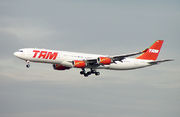TAM Airlines
 |
||||
|
||||
| Founded | 1976 | |||
|---|---|---|---|---|
| Hubs | ||||
| Focus cities |
|
|||
| Frequent-flyer program | TAM Fidelidade Multiplus Fidelidade |
|||
| Member lounge | VIP Lounge | |||
| Alliance | Star Alliance | |||
| Subsidiaries | TAM Airlines (Paraguay) Pantanal Linhas Aéreas |
|||
| Fleet size | 138 (+15 orders) | |||
| Destinations | 61 | |||
| Company slogan | Portuguese: Paixão por voar e servir English: Passion to fly and serve |
|||
| Headquarters | São Paulo, SP, Brazil | |||
| Key people | Líbano Barroso (CEO) | |||
| Website | http://www.tam.com.br | |||


TAM Airlines[4] (Portuguese: TAM Linhas Aéreas) (BM&F Bovespa: TAMM3, TAMM4 / NYSE: TAM) is Brazil's largest airline. It is headquartered in the city of São Paulo,[5] and operates scheduled services to destinations within Brazil, as well as international flights to Argentina, Chile, Uruguay, Paraguay, Peru, Venezuela, the United States, the United Kingdom, France, Spain, Italy and Germany. The company is traded on the São Paulo Exchange (BM&F Bovespa) and New York Stock Exchange as "TAM S.A."[6].
According to the National Civil Aviation Agency of Brazil (ANAC), between January and December 2009, TAM had 45.60% of the domestic and 86.47% of the international market shares in terms of passengers/km and in relation to the same period in 2008, it increased its share in the domestic market in 6.46% and in the international market it increased in 14.24%. In July 2010, its shares were of 43.00% for the domestic and 82.73% for the international markets.[7]
On August 13, 2010, TAM signed a non-binding agreement with Chilean airline LAN Airlines to merge and create LATAM Airlines Group.[8]
Contents |
History
TAM – Táxi Aéreo Marília
TAM – Táxi Aéreo Marília and TAM – Transportes Aéreos Regionais are two different judicial entities, though belonging to the same TAM Group. TAM – Marília, an air taxi company founded in 1961, provided the experience needed for the start-up of TAM – Regionais.
TAM – Transportes Aéreos Regionais (KK)
On November 11, 1975 the Brazilian Federal Government created the Brazilian Integrated System of Regional Air Transportation and divided the country in five different regions, to which five newly-created regional airlines received a concession to operate air services. TAM - Transportes Aéreos Regionais S/A was the third of those regional airlines to be made operational. Its services started on July 12, 1976 and its operational area comprised parts of the Southeast and Central West regions of Brazil, specifically the states of Mato Grosso do Sul, and parts of Mato Grosso, and São Paulo plus the possibility to serve the cities Cuiabá, Rio de Janeiro, Londrina, Maringá and Brasília when linking them to its area of concession.[9]
TAM-Linhas Aéreas Regionais was formed as a joint-venture between TAM-Táxi Aéreo Marília and VASP, then a state-owned airline. The airline received the IATA code KK[10] and flew Embraer EMB 110 Bandeirantes at first. These, however, proved grossly inadequate for the task at hand, and even at full capacity needed to be subsidized by the government in order to be profitable.
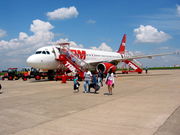
TAM went on to purchase three used Fokker F27 turboprops, which were then refurbished by Fokker in Holland. In order to obtain the import authorization for the aircraft, a deal was struck with the government where TAM was forced to maintain 3 Bandeirantes for every F27, as well as removing 5 seats from each one, bringing the F27's capacity down to 40 passengers. A fourth F27, previously owned by Air New Zealand, was incorporated in 1981. TAM would eventually own 10 F27s by 1983.
By 1981, TAM had flown 1 million passengers, and 2 million by 1984.
TAM (KK) and TAM (JJ) growth
In August 1986 the company, under financial stress, went public and began floating stock in the market. The same year, TAM - Transportes Aéreos Regionais (KK) acquired another regional airline, VOTEC, which operated in areas of northern and central Brazil. VOTEC was renamed Brasil Central Linhas Aéreas. TAM and Brasil Central, were both regional airlines and operated in different designated areas. They however operated as a consortium with integrated networks and fleet, being the most notable differences the flight-number IATA codes, the color scheme of the aircraft and the areas where they were authorized to operate: whereas TAM - Transportes Aéreos Regionais flights had the IATA code KK, Brasil Central operated with the code JJ inherited from Votec; each one kept a different color scheme and operated in their own designated areas.
On May 15, 1990 the Brazilian Government lifted restrictions on operational areas of regional airlines allowing them to fly anywhere in Brazil. As a consequence, Brasil Central was renamed TAM - Transportes Aéreos Meridionais, acquired the same color scheme of TAM (KK) but maintained the IATA code JJ. In 2000 TAM (KK) was merged into TAM (JJ) and TAM (JJ) was renamed TAM Transportes Aéreos. The IATA code KK is now used by Atlasjet.
In 1988, TAM flew its 3 millionth passenger.
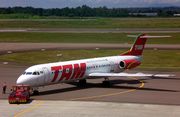
Despite TAM's success in the market, it was evident the airline would not last long when competing against airlines such as Varig and VASP which already possessed Boeing 737s in their fleet. Amaro then tried to buy VASP, about to be privatized, and called the project "Revolution". Having lost the bid, he opted for a slower growth with a gradual addition of new aircraft, re-dubbed "Evolution".
On September 15, 1989, TAM arranged for the acquisition of two Fokker 100 jets, which had originally been ordered by the now-bankrupt Pan American World Airways. Like the F27s before them, TAM did not actually purchase them, but used Amaro's credibility to arrange for a third-party asset management company, Guinness Peat Aviation to purchase them and subsequently lease them back to TAM. Two more were added in 1991. In 1992, TAM carried its eight millionth passenger. By 1993, through the use of the Fokker 100 fleet which now numbered at 14, TAM was serving 56 cities in Brazil.
In 1996, TAM bought another air company, Helisul, which used the trade name of TAM. In 1997, TAM ordered its first large jets; the airline ordered 45 planes from Airbus, including 10 A330s, 4 A319s, and 34 A320s. In 1997, the Airbuses began to be delivered and the airline flew its first international service, from São Paulo to Miami International Airport.
Two years later, in 1999, services to Europe were inaugurated through a code share service with Air France, to Paris-Charles de Gaulle Airport. In 2000 the airline was renamed TAM Linhas Aéreas in Portuguese. Long running discussions to merge with Varig ended in 2004. In 2008, TAM transported 30,144,000 passengers, with an average load factor of 71%.[11]
As of 2010, the airline is owned by the Amaro family (46.25%), Amaro Aviation Part (3.52%), treasury stocks (0.27%) and minority shareholders (49.96%). It employs 24,000 staff.[11]
On May 13, 2010 TAM became the 27th member of Star Alliance.[12]
Subsidiaries TAM (PZ) and Pantanal (P8)
In 1994 TAM Airlines established a small subsidiary airline in Paraguay, called ARPA - Aerolíneas Paraguayas, with a fleet consisting mostly of Cessna 208 Caravan aircraft, formerly operated by TAM. On September 1, 1996, TAM via ARPA purchased 80% of the shares of the former state-owned LAP - Líneas Aéreas Paraguayas and merged it with ARPA. The new airline was named TAM - Transportes Aéreos del Mercosur and maintained the IATA code of LAP, PZ. Today TAM owns 94.98% and the Paraguayan government 5.02% of the shares.
In 2008, following a branding strategy, the name TAM Mercosur was dropped and the airline adopted an identical corporate identity of TAM Airlines. However, its corporate structure remains the same.[13]
On December 21, 2009 TAM Airlines purchased Pantanal Linhas Aéreas. TAM however decided to maintain Pantanal as a different airline within the TAM Group and integrated into its network of TAM.[14] Presently Pantanal operates some flights on behalf of TAM, particularly those with origin and destination at São-Paulo-Congonhas Airport.
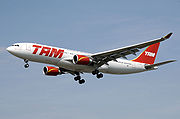
Destinations
TAM Airlines has an extensive network covering Brazil, Europe, North and South America. Furthermore, TAM maintains code-share agreements to serve other international destinations with Star Alliance partners, LAN Airlines, and PLUNA, and domestic destinations with NHT Linhas Aéreas, Passaredo Linhas Aéreas, and TRIP Linhas Aéreas.
Fleet
On June 16, 2005, TAM announced the purchase of 20 additional Airbus A320 family aircraft (including all the models A319, A320 and A321), plus an additional 20 options. These are expected to be delivered between late 2007 and 2010, adding to the already scheduled delivery of 6 A320s between 2006 and 2008. At the same time, the company signed a memorandum of understanding with Airbus stating its intent to buy 10 of the new Airbus A350-900 (plus 5 options), with deliveries due to commence at the end of 2012. These are expected to replace the A330 on the Paris and Miami routes as they become available.
TAM has signed a firm contract with Airbus to acquire 37 additional aircraft. The order comprises 12 A319s, 16 A320s, 3 A321s and 3 A330s and includes 12 unspecified extra options. This would bring TAMs fleet, acquired directly from Airbus to 115 aircraft [15] The commitments are separate from deals last year for 29 firm-ordered A320s and 20 options. The deliveries are to be concluded by 2010.
Fleet maintenance is partly conducted at the technology center at São Carlos Airport [16][17]
The fleet of TAM Airlines includes the following aircraft (at August 2010):[18]
| Aircraft | Total | Orders | Passengers[21] (First/Business/Economy) |
Notes |
|---|---|---|---|---|
| Airbus A319-100 | 23 | 1 | 144 (0/144) | since 1999 |
| Airbus A320-200 | 81 | 9 | 174 (0/174) 156 (12/144) |
since 1999 |
| Airbus A321-200 | 7 | - | 220 (0/220) | since 2007 |
| Airbus A330-200 | 18 | 1 | 223 (4/36/183) | since 1997 |
| Airbus A340-500 | 2 | - | 267 (42/225) | since 2007 |
| Boeing 767-300ER | 3 | - | 205 (30/175) | since 2008 to be phased out by 2013 |
| Boeing 777-300ER | 4 | 4 | 362 (4/56/302) | since 2008 |
| Total | 138 | 15 | - | - |
| Aircraft | Total | Years of operation |
|---|---|---|
| Embraer EMB 110 Bandeirante | 1976 – 1996 | |
| Fokker F27 | 1980 – 2000 | |
| Fokker 50 | 10 | 1990 – 2001 |
| Fokker 100 | 54 | 1991 – 2008 |
| McDonnell Douglas MD-11 | 3 | 2007 – 2008 |
TAM Fidelidade
TAM Fidelidade is the frequent flyer program of TAM Airlines. The program points can be reversed in tickets for TAM, Star Alliance and other partners. It is divided into the following categories and percentages of mileage accrual:
| Card Type | Points per year | Economy class | Business class | First class |
|---|---|---|---|---|
|
|
- |
|
|
|
|
|
12,000 |
|
|
|
|
|
48,000 |
|
|
|
|
|
150,000 |
|
|
|
Other subsidiaries
- TAM Cargo provides cargo services.[22]
- Multiplus Fidelidade is the customer loyalty network.[22]
- TAM Aviação Executiva provides air services for business executives.[22]
- TAM Viagens provides vacation package services for Brazilians,[22] while TAM Vacations provides vacation package services for Americans.[23][24]
- Cine TAM: a cinema in São Paulo owned by the airline.
- Wings of a Dream Museum: a museum of vintage aircraft located in São Carlos and maintained by TAM Group.[22]
Accidents and incidents
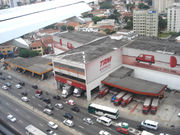
- 08 February 1979: an Embraer EMB 110 Bandeirante registration PT-SBB operating a flight from Bauru Airport to São Paulo-Congonhas Airport, while on initial climb from Bauru, truck trees and crashed into flames. All 2 crew and 16 passengers died.
- 4 July 1984: a second Bandeirante crashed in poor weather on approach near Macaé, killing all 17 people aboard.
- 12 February 1990: a Fokker F27 registration PT-LCG operating a flight from São Paulo-Congonhas Airport to Bauru Airport, due to faulty approach procedures touched down at Bauru 775m past the runway threshold. The pilot was unable to initiate a go around procedure and went past the end of the runway hitting a car that was passing on a road nearby. One crew member and 2 occupants of the car died.
- 31 October 1996: flight 402 crashed shortly after take-off from Congonhas, striking an apartment building and several houses. All 90 passengers and 6 crew members on board died. Three people were killed on ground. The crash was attributed to a faulty thrust-reverser in the right engine deploying after take-off.
- 9 July 1997: flight 283, a Fokker 100 at Suzano a bomb was detonated in the rear part of the passenger cabin. The uncontrolled decompression blew one passenger out of the aircraft. The plane landed safely despite a 10 by 5-foot (1.5 m) hole next to the right engine.[25]
- 17 July 2007: flight 3054[26] an Airbus A320 registration PR-MBK, on a flight from Porto Alegre with 186 passengers and crew[27], overran the runway at Congonhas-São Paulo Airport, crossed a major thoroughfare and impacted against a TAM Express warehouse.[28] 198 bodies were recovered from the crash site, including passengers and others on the ground.[29] This is considered to be the deadliest aviation accident in Latin America.[30]
References
- ↑ "Star Alliance Facts & Figures"
- ↑ "Star Alliance Facts & Figures"
- ↑ "Star Alliance Facts & Figures"
- ↑ "TAM Airlines." TAM Airlines. Retrieved on February 2, 2009.
- ↑ "Contact Us." TAM Airlines. Retrieved on September 21, 2009.
- ↑ "TAM S.A.," NYSE Euronext
- ↑ "Dados Comparativos Avançados" (in Portuguese). Agência Nacional de Aviação Civil (ANAC). http://www.anac.gov.br/dadosComparativos/DadosComparativos.asp. Retrieved 10 August 2010.
- ↑ "LAN says signs non-binding deal with TAM to merge". Reuters. 13 August 2010. http://www.reuters.com/article/idCNN1321787820100813?rpc=44. Retrieved 13 August 2010.
- ↑ Garófalo, Gílson de Lima (1982) (in Portuguese). O Mercado Brasileiro de Transporte Aéreo Regional. São Paulo: Instituto de Pesquisas Econômicas. pp. 103-107, 122-125.
- ↑ Home Page on October 13, 1999. TAM Transportes Aéreos Regionais
- ↑ 11.0 11.1 11.2 Airways magazine, Fast Facts - TAM Linhas Aereas, February 2010, p. 25
- ↑ "TAM Airlines joins Star Alliance". Star Alliance. 13 May 2010. http://www.staralliance.com/en/press/tam-launch-prp/. Retrieved 28 August 2010.
- ↑ "TAM Airlines Consolidates Fleet and Initiates New Air Network." Reuters. Monday May 26, 2008. Retrieved on February 2, 2009.
- ↑ "TAM compra Pantanal Linhas Aéreas por R$13 milhões" (in Portuguese). O Estado de São Paulo. 21 December 2009. http://www.estadao.com.br/noticias/economia,tam-compra-pantanal-linhas-aereas-por-r-13-milhoes,485269,0.htm. Retrieved 28 August 2010.
- ↑ Airliner World January 2007
- ↑ "Centro Tecnológico de São Carlos," TAM Airlines
- ↑ "Brazil MRO sector poised for major expansion". Flightglobal. 06 July 2010. http://www.flightglobal.com/articles/2010/07/06/343930/brazil-mro-sector-poised-for-major-expansion.html. Retrieved 06 July 2010.
- ↑ "Frota atual das empresas brasileiras" (in Portuguese). Aeromuseu. 28 August 2010. http://www.aeromuseu.com.br/frota.htm. Retrieved 28 August 2010.
- ↑ TAM Airlines fleet - Official website
- ↑ 20.0 20.1 http://www.airfleets.net/flottecie/TAM.htm
- ↑ http://www.seatplans.com/airlines/TAM-Brazilian-Airlines
- ↑ 22.0 22.1 22.2 22.3 22.4 "TAM Group Companies." TAM Airlines. Retrieved on August 12, 2010.
- ↑ http://www.tamviagens.com.br/
- ↑ http://www.tamvacations.com/
- ↑ TAM Linhas Aéreas Flight 283, Airdisaster.com
- ↑ (Portuguese)TAM says damage assessment is still not possible. Folha Online. Retrieved July 17, 2007.
- ↑ (English)'Many dead' in Brazil plane crash. BBC News. Retrieved July 17, 2007.
- ↑ (Portuguese)TAM Airplane loses control and hits warehouse. Folha Online. Retrieved July 17, 2007.
- ↑ Fiery plane crash at São Paulo airport kills at least 200
- ↑ "Acidente com o Airbus da TAM é o pior da América Latina." BBC Brasil. July 18, 2007. Retrieved on June 5, 2009.
- [1] (2007). TAM magazine.
- [2] (2007). TAM confirms purchase of 02 Airbus A340-500. São Paulo.
- Thales Guaracy(2003). O Sonho Brasileiro. São Paulo : A Girafa.
- [3](2005). TAM confirms purchase of 20 Airbus A319/A320/A321. São Paulo.
- [4](2006) . Airbus customer turns to Boeing with billion-dollar 777 order. The Seattle Times.
External links
- TAM Airlines
- TAM Passion to Fly and Serve
- TAM Vacations
- TAM Cargo
- TAM Táxi Aéreo Marília S.A.
- TAM Viagens
- TAM Executive Aviation
- Paixão por voar e servir
- Museu Asas de um Sonho (TAM Wings of a Dream Museum)
- TAM Regionais (KK) accidents on Aviation Safety Database
- TAM Airlines (JJ) accidents on Aviation Safety Database
- TAM Photo Archive at airliners.net
- TAM History sketch at Aviação Brasil
- TAM at YouTube
- National Civil Aviation Agency of Brazil (ANAC)
|
|||||
|
||||||||||||||||||||
|
||||||||||||||||||||||||||||||||||||||||||||||||||||||||||||||||||
|
|||||
